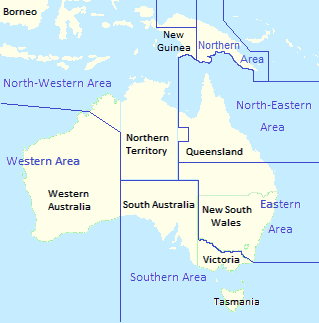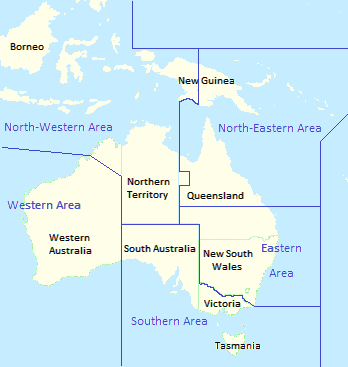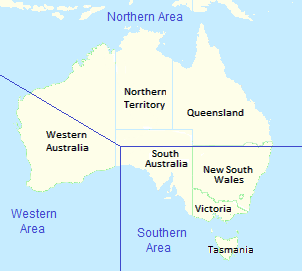|
Northern Command (RAAF)
Northern Command was one of several geographically based commands raised by the Royal Australian Air Force (RAAF) during World War II. Established in April 1944, it evolved from No. 9 Operational Group, which had been the RAAF's primary mobile formation in the South West Pacific theatre since September 1942, but had lately become a garrison force in New Guinea. Northern Command was headquartered initially at Milne Bay and then, from August 1944, in Madang. It conducted operations in New Guinea, New Britain, and Bougainville until the end of the war. Re-designated Northern Area in December 1945, it was headquartered in Port Moresby from March 1946 and disbanded in February 1947. History Prior to World War II, the Royal Australian Air Force was small enough for all its elements to be directly controlled by RAAF Headquarters in Melbourne. When war broke out, the RAAF began to decentralise its command structure, commensurate with expected increases in manpower a ... [...More Info...] [...Related Items...] OR: [Wikipedia] [Google] [Baidu] |
Western Area Command (RAAF)
Western Area Command was one of several geographically based commands raised by the Royal Australian Air Force (RAAF) during World War II. It was formed in January 1941, and controlled RAAF units located in Western Australia. Headquartered in Perth, Western Area Command was responsible for air defence, aerial reconnaissance and protection of the sea lanes within its boundaries. Its aircraft conducted anti-submarine operations throughout the war, and attacked targets in the Dutch East Indies during the Borneo campaign in 1945. The area command continued to operate after the war, but its assets and staffing were much reduced. Its responsibilities were subsumed in February 1954 by the RAAF's new functional commands: Home (operational), Training, and Maintenance Commands. Western Area headquarters was disbanded in November 1956. History World War II Prior to World War II, the Royal Australian Air Force was small enough for all its elements to be directly controlled by R ... [...More Info...] [...Related Items...] OR: [Wikipedia] [Google] [Baidu] |
Department Of Veterans' Affairs (Australia)
The Department of Veterans' Affairs is a department of the Government of Australia, established in 1976, and charged with the responsibility of delivering government programs for war veterans, members of the Australian Defence Force, members of the Australian Federal Police, and their dependants. The current Secretary of the Department of Veterans' Affairs is Elizabeth Cosson, who succeeded Simon Lewis as secretary on 19 May 2018. For administration purposes, the department forms part of the Defence portfolio. The Minister for Defence acts on behalf of the Minister for Veterans' Affairs within the Cabinet. Operational activities The functions of the department are broadly classified into the following matters: * Repatriation income support, compensation and health program for veterans, members of the Defence Force, certain mariners and their dependants *Commemorations, including promotion of understanding of Anzac Day, Remembrance Day and Vietnam Veterans' Day * War gr ... [...More Info...] [...Related Items...] OR: [Wikipedia] [Google] [Baidu] |
William Bostock
Air Vice Marshal William Dowling Bostock, (5 February 1892 – 28 April 1968) was a senior commander in the Royal Australian Air Force (RAAF). During World War II he led RAAF Command, the Air Force's main operational formation, with responsibility for the defence of Australia and air offensives against Japanese targets in the South West Pacific Area. His achievements in the role earned him the Distinguished Service Order and the American Medal of Freedom. General Douglas MacArthur described him as "one of the world's most successful airmen". A veteran of World War I, Bostock first saw combat as a soldier in the Australian Imperial Force at Gallipoli, then as a pilot in the Royal Flying Corps on the Western Front, where he earned the Belgian Croix de guerre. He joined the newly formed RAAF in 1921 and by 1941 had risen to become its third most senior officer, serving as Director of Training from 1930 to 1931, commanding officer of No. 3 Squadron from 1931 to 1936, ... [...More Info...] [...Related Items...] OR: [Wikipedia] [Google] [Baidu] |
RAAF Command
RAAF Command was the main operational arm of the Royal Australian Air Force (RAAF) during World War II. The command was formed in September 1942 and by April 1943 comprised 27 squadrons, including units from the Netherlands, the United Kingdom and the United States, as well as Australia. Coming under the operational authority of Allied Air Forces Headquarters in the South West Pacific Area, RAAF Command exercised control of its units through geographically based area commands in Australia and, later, New Guinea, as well as large mobile formations including the Australian First Tactical Air Force. The command reached a strength of 41 squadrons in October 1944. From the time of its establishment, until its disbandment in September 1945, it was led by Air Vice Marshal Bill Bostock. History Establishment and control Allied Air Forces (AAF) Headquarters was established under General Douglas Macarthur's South West Pacific Area (SWPA) command on 20 April 1942. All Royal Australian ... [...More Info...] [...Related Items...] OR: [Wikipedia] [Google] [Baidu] |
Australian First Tactical Air Force
The Australian First Tactical Air Force (No. 1 TAF) was formed on 25 October 1944 by the Royal Australian Air Force (RAAF). Its purpose was to provide a mobile force of fighter and ground attack aircraft that could support Allied army and naval units fighting the Empire of Japan in the South West Pacific Area. One of several Allied tactical air forces formed during World War II, it evolved from the RAAF's No. 10 Operational Group, established a year earlier. Following action in the assaults on Aitape and Noemfoor, the group was renamed the First Tactical Air Force to better reflect its size and role. It was beset with morale and leadership issues in early 1945, but recovered to take part in the battles of Tarakan, North Borneo, and Balikpapan. Reaching its peak strength of over 25,000 personnel in July 1945, No. 1 TAF's squadrons operated such aircraft as the P-40 Kittyhawk, Supermarine Spitfire, Bristol Beaufighter, and B-24 Liberator. The formation remained active fol ... [...More Info...] [...Related Items...] OR: [Wikipedia] [Google] [Baidu] |
Empire Of Japan
The also known as the Japanese Empire or Imperial Japan, was a historical nation-state and great power that existed from the Meiji Restoration in 1868 until the enactment of the post-World War II 1947 constitution and subsequent formation of modern Japan. It encompassed the Japanese archipelago and several colonies, protectorates, mandates, and other territories. Under the slogans of and following the Boshin War and restoration of power to the Emperor from the Shogun, Japan underwent a period of industrialization and militarization, the Meiji Restoration, which is often regarded as the fastest modernisation of any country to date. All of these aspects contributed to Japan's emergence as a great power and the establishment of a colonial empire following the First Sino-Japanese War, the Boxer Rebellion, the Russo-Japanese War, and World War I. Economic and political turmoil in the 1920s, including the Great Depression, led to the rise of militarism, nationa ... [...More Info...] [...Related Items...] OR: [Wikipedia] [Google] [Baidu] |
Eastern Area Command (RAAF)
Eastern Area Command was one of several geographically based commands raised by the Royal Australian Air Force (RAAF) during . It was formed in May 1942, and controlled units located in New South Wales and southern Queensland. Headquartered in Sydney, Eastern Area Command's responsibilities included air defence, aerial reconnaissance and protection of the sea lanes within its boundaries. Its flying units operated fighters, reconnaissance bombers, and dive bombers, and concentrated on convoy escort, maritime patrol and anti-submarine warfare. The size of the area was such that the RAAF twice considered splitting it, but nothing came of this. The area command continued to function after the war, its headquarters transferring from Sydney to Glenbrook, in the Blue Mountains, in 1949. By this time most of the RAAF's operational units—including fighter, bomber, and transport wings—were based within Eastern Area's boundaries, and the officer in command was responsible for air ... [...More Info...] [...Related Items...] OR: [Wikipedia] [Google] [Baidu] |
North-Western Area Command (RAAF)
North-Western Area Command was one of several geographically based commands raised by the Royal Australian Air Force (RAAF) during World War II. Its wartime sphere of operations included the Northern Territory, adjacent portions of Queensland and Western Australia, and the Dutch East Indies. The command was formed in January 1942, following the outbreak of the Pacific War, from the western part of Northern Area Command, which had covered all of northern Australia and Papua. Headquartered at Darwin, North-Western Area Command was initially responsible for air defence, aerial reconnaissance and protection of the sea lanes within its boundaries. In the official history of the RAAF in the Pacific theatre, George Odgers described the North-Western Area Campaign as "almost entirely an air war, with raid and counter-raid". From 1943, North-Western Area Command's role became increasingly offensive in nature, as the Allies began to advance in New Guinea and the Dutch East Indie ... [...More Info...] [...Related Items...] OR: [Wikipedia] [Google] [Baidu] |
North-Eastern Area Command (RAAF)
North-Eastern Area Command was one of several RAAF area commands, geographically based commands raised by the Royal Australian Air Force (RAAF) during World War II. For most of its existence it controlled units based in central and northern Queensland as well as Papua New Guinea. It was formed in January 1942 from the eastern part of the former Northern Area Command (RAAF), Northern Area Command, which had covered all of northern Australia and Territory of Papua, Papua. Headquartered at Townsville, Queensland, North-Eastern Area Command's responsibilities included Anti-aircraft warfare, air defence, aerial reconnaissance and protection of the sea lanes within its territory. Its flying units, equipped with fighters, reconnaissance bombers, dive bombers and transports, took part in the Battle of Rabaul (1942), battles of Rabaul, Battle of Port Moresby, Port Moresby and Battle of Milne Bay, Milne Bay in 1942, and the Battle of Hollandia, landings at Hollandia and Landing at Aitape, ... [...More Info...] [...Related Items...] OR: [Wikipedia] [Google] [Baidu] |
Aerial Reconnaissance
Aerial reconnaissance is reconnaissance for a military or strategic purpose that is conducted using reconnaissance aircraft. The role of reconnaissance can fulfil a variety of requirements including artillery spotting, the collection of imagery intelligence, and the observation of enemy maneuvers. History Early developments After the French Revolution, the new rulers became interested in using the balloon to observe enemy manoeuvres and appointed scientist Charles Coutelle to conduct studies using the balloon ''L'Entreprenant'', the first military reconnaissance aircraft. The balloon found its first use in the 1794 conflict with Austria, where in the Battle of Fleurus they gathered information. Moreover, the presence of the balloon had a demoralizing effect on the Austrian troops, which improved the likelihood of victory for the French troops. To operate such balloons, a new unit of the French military, the French Aerostatic Corps, was established; this organisatio ... [...More Info...] [...Related Items...] OR: [Wikipedia] [Google] [Baidu] |









